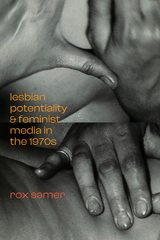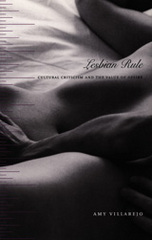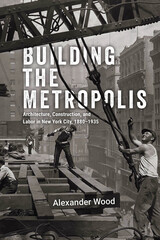4 books about Lesbian feminist theory

The Essential Jill Johnston Reader
Jill Johnston. Edited by Clare Croft
Duke University Press, 2024
Jill Johnston began the 1960s as an influential dance columnist for the Village Voice and by the start of the next decade she was known as a keen observer of postmodern art and lesbian feminist life who challenged how dance, art, and women can and should be seen. The Essential Jill Johnston Reader collects dozens of pieces of her writing from across her career. These writings—many of which appeared in the Village Voice and the New York Times—survey the breadth of her work, braiding together her thinking, writing, and activism. From personal essays, travel writing, and artist profiles to dance and visual art reviews as well as her infamous series of columns for the Voice in which she came out as a lesbian, these pieces demonstrate the evolution of her philosophies and writing style. Illustrating how Johnston drew on lessons from dance to reconsider what it means to be a woman, this collection brings a fascinating and brilliant voice of American arts criticism, radical feminism, and gay liberation back to contemporary audiences.
[more]

Jill Johnston in Motion
Dance, Writing, and Lesbian Life
Clare Croft
Duke University Press, 2024
Performer, activist, and writer Jill Johnston was a major queer presence in the history of dance and 1970s feminism. She was the first critic to identify postmodernism’s arrival in American dance and was a fierce advocate for the importance of lesbians within feminism. In Jill Johnston in Motion, Clare Croft tracks Johnston’s entwined innovations and contributions to dance and art criticism and activism. She examines Johnston’s journalism and criticism—in particular her Village Voice columns published between 1960 and 1980—and her books of memoir and biography. At the same time, Croft attends to Johnston’s appearances as both dancer and audience member and her physical and often spectacular participation at feminist protests. By bringing together Johnston’s criticism and activism, her writing and her physicality, Croft emphasizes the effect that the arts, particularly dance, had on Johnston’s feminist thinking in the 1970s and traces lesbian feminism’s roots in avant-garde art practice.
[more]

Lesbian Potentiality and Feminist Media in the 1970s
Jed Samer
Duke University Press, 2022
In Lesbian Potentiality and Feminist Media in the 1970s, Jed Samer explores how 1970s feminists took up the figure of the lesbian in broad attempts to reimagine gender and sexuality. Samer turns to feminist film, video, and science fiction literature, offering a historiographical concept called “lesbian potentiality”—a way of thinking beyond what the lesbian was, in favor of how the lesbian signified what could have come to be. Samer shows how the labor of feminist media workers and fans put lesbian potentiality into movement. They see lesbian potentiality in feminist prison documentaries that theorize the prison industrial complex’s racialized and gendered violence and give image to Black feminist love politics and freedom dreaming. Lesbian potentiality also circulates through the alternative spaces created by feminist science fiction and fantasy fanzines like The Witch and the Chameleon and Janus. It was here that author James Tiptree, Jr./Alice B. Sheldon felt free to do gender differently and inspired many others to do so in turn. Throughout, Samer embraces the perpetual reimagination of “lesbian” and the lesbian’s former futures for the sake of continued, radical world-building.
[more]

Lesbian Rule
Cultural Criticism and the Value of Desire
Amy Villarejo
Duke University Press, 2003
With hair slicked back and shirt collar framing her young patrician face, Katherine Hepburn's image in the 1935 film Sylvia Scarlett was seen by many as a lesbian representation. Yet, Amy Villarejo argues, there is no final ground upon which to explain why that image of Hepburn signifies lesbian or why such a cross-dressing Hollywood fantasy edges into collective consciousness as a lesbian narrative. Investigating what allows viewers to perceive an image or narrative as "lesbian," Villarejo presents a theoretical exploration of lesbian visibility. Focusing on images of lesbians in film, she analyzes what these representations contain and their limits. She combines Marxist theories of value with poststructuralist insights to argue that lesbian visibility operates simultaneously as an achievement and a ruse, a possibility for building a new visual politics and away of rendering static and contained what lesbian might mean.
Integrating cinema studies, queer and feminist theory, and cultural studies, Villarejo illuminates the contexts within which the lesbian is rendered visible. Toward that end, she analyzes key portrayals of lesbians in public culture, particularly in documentary film. She considers a range of films—from documentaries about Cuba and lesbian pulp fiction to Exile Shanghai and The Brandon Teena Story—and, in doing so, brings to light a nuanced economy of value and desire.
Integrating cinema studies, queer and feminist theory, and cultural studies, Villarejo illuminates the contexts within which the lesbian is rendered visible. Toward that end, she analyzes key portrayals of lesbians in public culture, particularly in documentary film. She considers a range of films—from documentaries about Cuba and lesbian pulp fiction to Exile Shanghai and The Brandon Teena Story—and, in doing so, brings to light a nuanced economy of value and desire.
[more]
READERS
Browse our collection.
PUBLISHERS
See BiblioVault's publisher services.
STUDENT SERVICES
Files for college accessibility offices.
UChicago Accessibility Resources
home | accessibility | search | about | contact us
BiblioVault ® 2001 - 2025
The University of Chicago Press









